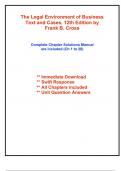The Legal Environment of Business
Text and Cases, 12th Edition by
Frank B. Cross
Complete Chapter Solutions Manual
are included (Ch 1 to 28)
** Immediate Download
** Swift Response
** All Chapters included
** Unit Question Answers
,Table of Contents are given below
1. Law and Legal Reasoning.
2. Business and the Constitution.
3. Ethics in Business.
4. Courts and Alternative Dispute Resolution.
5. Court Procedures.
6. Tort Law.
7. Strict Liability and Product Liability.
8. Intellectual Property Rights.
9. Internet Law, Social Media, and Privacy.
10. Criminal Law and Cyber Crime.
11. International and Space Law.
12. Formation of Traditional and E-Contracts.
13. Contract Performance, Breach, and Remedies.
14. Sales and Lease Contracts.
15. Creditor-Debtor Relations and Bankruptcy.
16. Small Businesses and Franchises.
17. Limited Liability Business Forms.
18. Corporations.
19. Agency Relationships.
20. Employment Law.
21. Employment Discrimination.
22. Immigration and Labor Law.
23. Administrative Agencies.
24. Consumer Protection.
25. Environmental Law.
26. Real Property and Land-Use Control.
27. Antitrust Law.
28. Investor Protection and Corporate Governance.
,Solutions Manual organized in reverse order, with the last chapter displayed first, to
ensure that all chapters are included in this document.
(Complete Chapters included Ch28-1)
Solution and Answer Guide
CROSS, THE LEGAL ENVIRONMENT OF BUSINESS, 2025, 9780357985700;
CHAPTER 28: INVESTOR P ROTECTION, INSIDER TRADING, AND CORPORATE GOVERNANCE
TABLE OF CONTENTS
Answers to Critical Thinking Questions in the Features .......................................................................1
Digital Update—Critical Thinking .............................................................................................................. 1
Ethics Today—Critical Thinking ................................................................................................................. 1
Answers to Questions at the Ends of the Cases ...................................................................................2
Case 28.1—Critical Thinking ..................................................................................................................... 2
Case 28.2—Legal Reasoning Questions .................................................................................................... 3
Case 28.3—Critical Thinking ..................................................................................................................... 3
Answers to Questions in the Practice and Review Feature at the End of the Chapter ...........................4
Answer to Debate This Question in the Practice and Review Feature of the End of the Chapter ...........5
Answers to Issue Spotters at the End of the Chapter ...........................................................................5
Answers to Business Scenarios and Case Problems at the End of the Chapter ......................................5
Answers to Time-Limited Group Assignment Questions at the End of the Chapter ............................. 13
ANSWERS TO CRITICAL THINKING QUESTIONS IN THE FEATURES
DIGITAL UPDATE—CRITICAL THINKING
1. What alternatives are there to crowdfunding for a start-up business?
Answer: A start-up can obtain funding via loans from friends and family. Owners of start-ups often
take out second mortgages on their homes to obtain financing. Start-ups can go to venture capitalists
to request funding. Occasionally, start-ups can obtain bank financing. Usually, though, banks require
that all members of the start-up sign personal guarantees for any funds loaned.
ETHICS TODAY—CRITICAL THINKING
1. Why has the most pressure concerning the composition of boards of directors come from large
institutional investors, such as mutual funds?
Answer: Clearly, the effectiveness of individual shareholders on the composition of boards of
directors is slight. Therefore, if there is a movement toward having more women on boards of
directors, for such a movement to succeed, many shareholders must be behind this effort. Mutual
funds, for example, represent many shareholders. Hence, if mutual funds wish to encourage
, corporations to add more women to their boards of directors, those mutual funds will be more
successful than individual shareholders.
ANSWERS TO QUESTIONS AT THE ENDS OF THE CASES
CASE 28.1—CRITICAL THINKING
1. Legal Environment. Scoville argued that Adpacks were not investment contracts because there was no
guarantee that buyers would receive a return on their investment. Should the court have ruled in
Scoville’s favor based on this argument? Explain.
Answer: No. Very few investments guarantee a return. To qualify as an investment contract, the
investor, or buyer, only has to have a reasonable expectation of profits. As long as a transaction
satisfies the Howey test for an investment contract, it is immaterial whether the investment is
speculative.
Scoville argued that Adpacks were not investment contracts because Traffic Monsoon’s obligation to
share its revenue was contingent on there being revenue to share with no guarantee this would
happen. In fact, Traffic Monsoon’s website stated that there was no guarantee there would be
revenue for Adpack buyers to share.
But based on Scoville’s other representations, including the touted high rates of return, the Adpack
buyers had a reasonable expectation of obtaining a share of Traffic Monsoon’s revenue. And this was
enough to meet the requirements of the test set out in the Howey case (in which the investors were
likewise not guaranteed a return on their investment).
2. Economic. The return on an investment in an Adpack was not based on any underlying business activity.
Instead, money from new investors was used to pay earlier investors. Is this a legitimate business model?
Discuss.
Answer: No. The Adpack business model—using money from new investors to generate returns for
earlier investors—was likely to be established at trial as what is known as a Ponzi scheme. This sort of
set-up is not legitimate because it is deceptive, generating a false appearance of profitability.
The central characteristic of a Ponzi scheme is that returns are not based on any underlying business
activity. Instead, as in this case, money from new investors is used to pay earlier investors. And often,
as also appears to have occurred in this case, the money contributed by later investors generates
artificially high dividends for the earlier investors. This may attract even more investors.
Traffic Monsoon misrepresented the source of the revenue shared with Adpack investors. Although
the company realized some income from its other advertising services, there was essentially no
business activity generating the revenue shared with Adpack buyers except the amounts received
from the sales of new Adpacks. This deception made the business illegitimate and likely that it would
be established as a Ponzi scheme.
CASE 28.2—LEGAL REASONING QUESTIONS
1. What did the defendant’s “test the waters” communications involve?
Answer: In this case, the actual “test the waters” communications were not specifically written.
Rather, these communications that were not part of the prospectus (offering circular) simply did not




